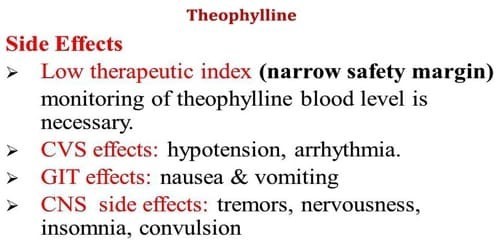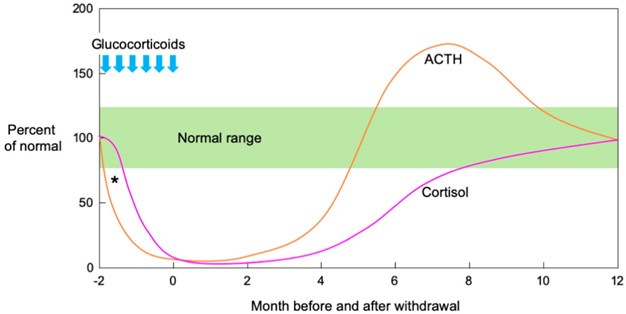A nurse is providing discharge instructions to a client who has asthma and is about to start taking theophylline (Theo-24). The nurse should tell the client that this medication might cause which of the following adverse effects?
Constipation
Oliguria
Drowsiness
Dysrhythmias
The Correct Answer is D
Theophylline is a bronchodilator medication used in the treatment of asthma and other respiratory conditions. It works by relaxing the smooth muscles in the airways, allowing for easier breathing. However, theophylline is associated with potential adverse effects, and one of the most significant concerns is its potential to cause dysrhythmias (irregular heart rhythms).
Dysrhythmias can include tachycardia (rapid heart rate), atrial fibrillation, or other disturbances in heart rhythm.
Constipation is not a commonly reported adverse effect of theophylline. Oliguria (decreased urine output) is not typically associated with theophylline use. Drowsiness can occur with theophylline, but dysrhythmias are considered a more significant and potentially serious adverse effect. It is crucial for the nurse to educate the client about the potential for dysrhythmias and advise them to report any irregular heartbeat or other cardiac symptoms promptly.

Nursing Test Bank
Naxlex Comprehensive Predictor Exams
Related Questions
Correct Answer is A
Explanation
Nasal glucocorticoids are commonly used to treat allergic rhinitis and work by reducing inflammation in the nasal passages. However, one of the potential side effects of using these medications is the drying of the nasal mucosa, which can lead to discomfort and occasional nosebleeds. It is important for clients to be aware of this side effect and to take appropriate measures to mitigate it, such as using a humidifier, staying hydrated, and gently applying a saline nasal spray if needed.
Rhinorrhea refers to a runny nose and is not a common side effect of fluticasone or other nasal glucocorticoids. Dizziness and hallucinations are also not typical side effects associated with the use of fluticasone. However, it is important to note that individual responses to medications can vary, and if a client experiences any unusual or concerning side effects while taking fluticasone, they should consult their healthcare provider for further evaluation.
Correct Answer is C
Explanation
Prednisone is a corticosteroid medication commonly used to treat asthma and other inflammatory conditions. When taken for a prolonged period at higher doses, it can suppress the body's natural production of cortisol, a hormone produced by the adrenal glands. Abruptly stopping prednisone after long-term use can lead to adrenocortical insufficiency, also known as adrenal insufficiency or adrenal crisis.
Adrenocortical insufficiency occurs because the body's adrenal glands need time to resume normal cortisol production after being suppressed by prednisone. Gradually reducing the dose of prednisone allows the adrenal glands to gradually increase their cortisol production, minimizing the risk of adrenal insufficiency.
Rebound pulmonary congestion, hyperglycemia, and severe dehydration are not specific adverse effects associated with discontinuing prednisone. However, it is important for clients who have been taking prednisone to follow their healthcare provider's instructions regarding the tapering schedule and any potential risks or side effects.

Whether you are a student looking to ace your exams or a practicing nurse seeking to enhance your expertise , our nursing education contents will empower you with the confidence and competence to make a difference in the lives of patients and become a respected leader in the healthcare field.
Visit Naxlex, invest in your future and unlock endless possibilities with our unparalleled nursing education contents today
Report Wrong Answer on the Current Question
Do you disagree with the answer? If yes, what is your expected answer? Explain.
Kindly be descriptive with the issue you are facing.
